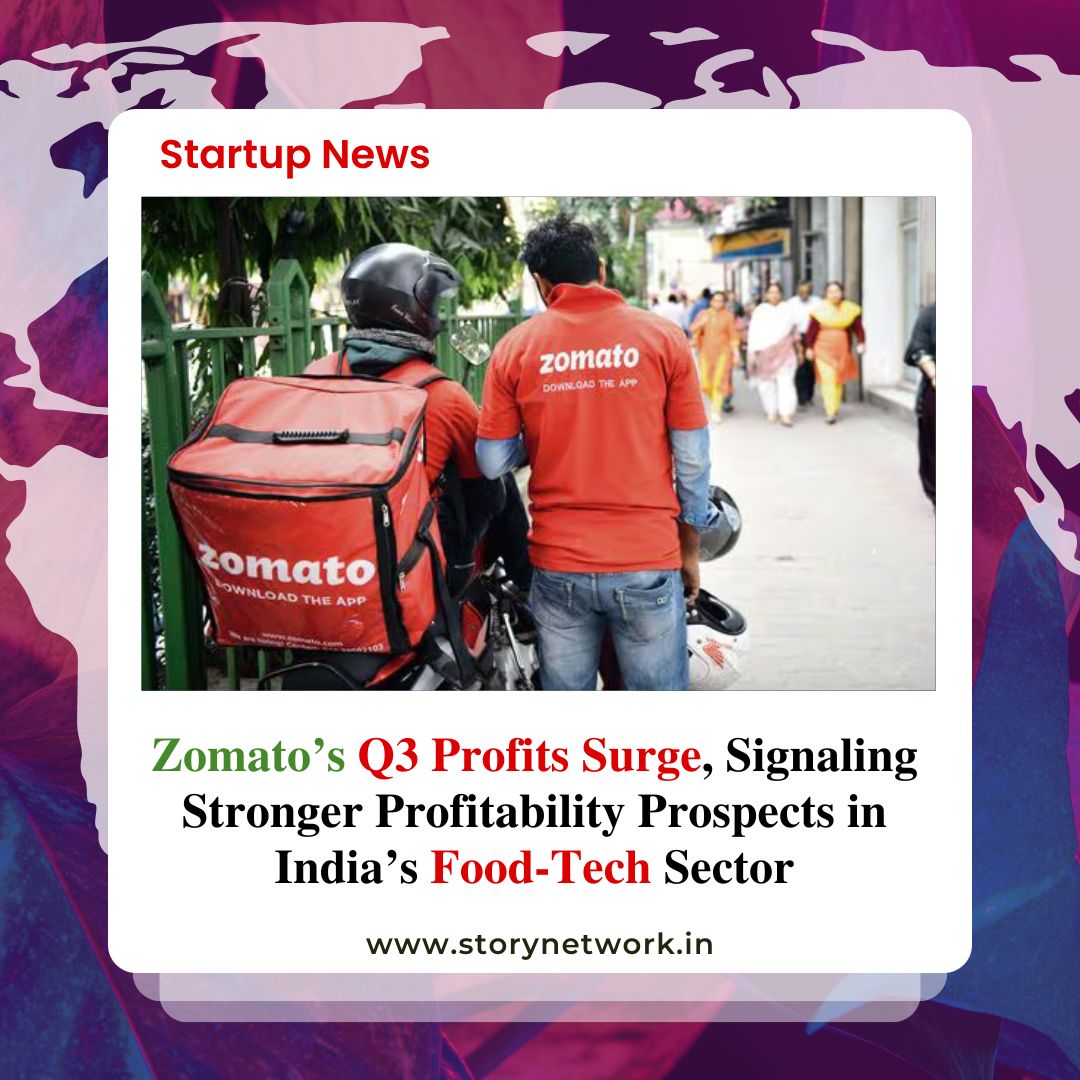Zomato’s Q3 Profits Surge, Signaling Stronger Profitability Prospects in India’s Food-Tech Sector
In a significant financial milestone, Zomato, one of India’s largest food delivery platforms, reported a remarkable 283% increase in profits, reaching ₹138 crore in the third quarter of FY24. This achievement not only underscores Zomato’s growing dominance in the food-tech sector but also highlights the burgeoning profitability potential within India’s digital food delivery landscape. This sector, which has seen increased consumer and investor interest in recent years, is navigating a path toward profitability despite a challenging economic environment.
A Closer Look at the Q3 Performance
Zomato’s third-quarter results showcase a decisive leap forward. The platform recorded ₹138 crore in net profit, a substantial increase from the previous quarter’s figures and a stark contrast to its earlier quarters marked by losses. This positive outcome is attributed to a combination of factors, including higher order volumes, operational efficiency, and strategic financial management aimed at reducing costs while expanding reach.
The growth in Zomato’s profits reflects the company’s commitment to streamlining operations, reducing delivery expenses, and maintaining customer loyalty amid intensifying competition. This 283% rise in quarterly profits represents more than a financial improvement; it signals a shift in the food delivery industry’s landscape, which has often struggled with sustainability and cost management.
Revenue Growth Driven by Increased Consumer Demand
A key driver of Zomato’s recent financial success is a sustained increase in consumer demand. The third quarter saw a notable rise in order frequency and basket size, highlighting the increased reliance on food delivery services among Indian consumers. This shift is attributed to evolving consumer behavior, accelerated by the COVID-19 pandemic, which has led to a growing preference for convenience-based services.
In addition to growth in urban markets, Zomato’s penetration into smaller towns and semi-urban areas has contributed significantly to its expanding customer base. By targeting these regions and enhancing its platform’s accessibility, Zomato has successfully tapped into new demand segments, further supporting revenue growth.
Operational Efficiency: A Strategic Move Toward Profitability
Behind Zomato’s impressive financial turnaround lies a focused strategy on operational efficiency. The company has made significant investments in technology to streamline its delivery processes and reduce overheads. By leveraging data analytics and artificial intelligence, Zomato has improved route optimization for delivery drivers, reduced delivery times, and enhanced customer satisfaction.
Moreover, the company has implemented cost-cutting measures that include optimizing its supply chain and negotiating favorable terms with restaurant partners. These initiatives have allowed Zomato to minimize operational costs and maximize its profit margins, even as it continues to expand its network and reach new customers.
Investor Confidence and Market Response
The financial markets have responded positively to Zomato’s recent performance. Investor confidence in the platform has strengthened, with Zomato’s stock witnessing notable gains following the Q3 announcement. The company’s growth trajectory has reassured investors who have long sought signs of profitability in India’s highly competitive food-tech sector.
This newfound profitability marks a pivotal shift for Zomato, positioning it as a leader not just in market share but also in financial stability. The company’s ability to sustain profitability could set a new benchmark for other players in the industry, particularly as competition from Swiggy and new entrants intensifies.
Challenges and Future Outlook
Despite the promising results, Zomato continues to face challenges that could impact its long-term profitability. Rising inflation, increased fuel prices, and potential fluctuations in consumer spending pose ongoing risks. Additionally, competition in the food delivery market remains fierce, with rival platforms offering aggressive discounts and loyalty programs to capture market share.
To address these challenges, Zomato has hinted at plans to diversify its offerings. The company recently entered the quick-commerce segment, providing grocery deliveries through Blinkit, which it acquired to complement its core food delivery business. This move could reduce its dependence on food delivery alone and generate new revenue streams. However, the quick-commerce industry presents its own set of challenges, such as high operational costs and logistical hurdles.
Industry Implications and a Path Forward
Zomato’s recent success may serve as a blueprint for other startups in the food-tech sector. The ability to balance expansion with profitability is a valuable lesson for companies striving to succeed in a market that has historically prioritized growth over financial stability. As Zomato demonstrates, focusing on operational efficiency, customer loyalty, and diversified offerings can yield sustained profitability, even in challenging markets.
Looking ahead, Zomato’s future growth will likely depend on its ability to maintain operational efficiencies while expanding its service offerings. The company has indicated that it will continue exploring technology-driven innovations and customer-centric strategies to retain its competitive edge. The challenge will be to scale these initiatives sustainably, without compromising profitability or customer satisfaction.
Conclusion: A Turning Point for Zomato and the Indian Food-Tech Sector
Zomato’s latest quarterly results underscore a transformative moment for the company and signal positive prospects for India’s food-tech industry. With a 283% increase in profits, Zomato has shown that profitability is achievable within the food delivery space, provided companies can manage costs effectively and leverage technology to enhance customer experience.
The platform’s strategic focus on operational efficiency and expansion into new markets has enabled it to capture a significant share of India’s digital food delivery sector. As Zomato continues to explore new opportunities, including quick commerce, it is well-positioned to influence the future direction of the food-tech sector. The company’s achievements mark a new chapter in the journey of Indian food delivery services, where profitability and innovation are emerging as the key pillars of success.




